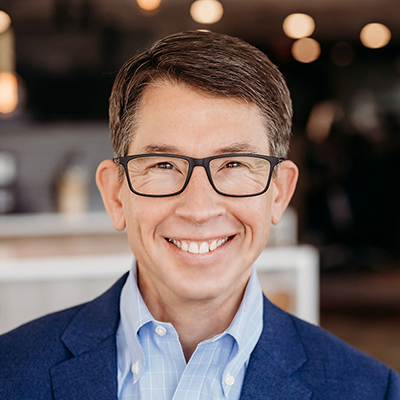| “Oh, the places you’ll go!” reflected HR Policy Association Chair Pam Kimmet, CHRO at Manulife, as she launched the organization’s 56thAnnual CHRO Summit in Orlando, Florida last week. As attendees discussed the latest developments in the use of artificial intelligence in the workplace, the reinvigoration of union activity, and the future of HR, Ms. Kimmet summed it up by noting, “we are on the precipice of exciting issues and the exciting thing is that there’s no right answers, just the best answers for our organizations and how we want to evolve.” With nearly 200 attendees and 12 general and concurrent sessions featuring 16 CHRO panelists, this week’s newsletter provides detailed summaries of the essential discussions held throughout our three-day event. For a complete Summit digest, including thought leadership sessions from Dr. Michael Gervais on CHRO leadership and resilience, Dr. Timothy Naftali on the global socio-political environment, and the Hon. Val Demings on 2024 election implications for large companies, please see below. | 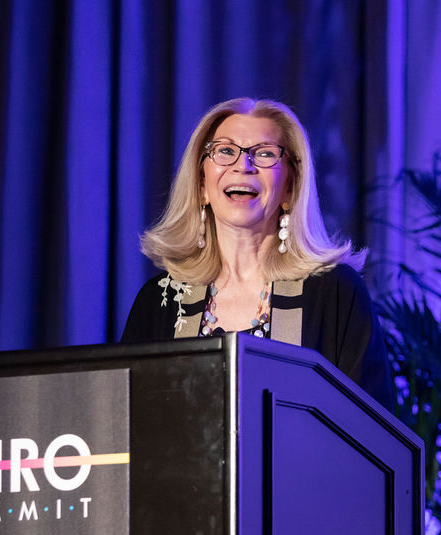 “We are on the precipice of exciting issues and the exciting thing is that there’s no right answers, just the best answers for our organizations and how we want to evolve.” - Pamela O. Kimmet
|
Artificial Intelligence: The Promise & Peril for HR
To kick off HR Policy’s Annual CHRO Summit, a panel of CHROs and AI experts discussed the implications of increased integration of artificial intelligence into the workplace, particularly within HR functions. Moderator Susan Podlogar, CHRO of MetLife, set the foundation for the panel, noting that AI is a change accelerator and CHROs need to ask whether they and their workforces are prepared for the impact of the change. Top considerations for CHROs should be whether the organization is healthy, the culture is strong, and if the application of AI will be fair and equitable.
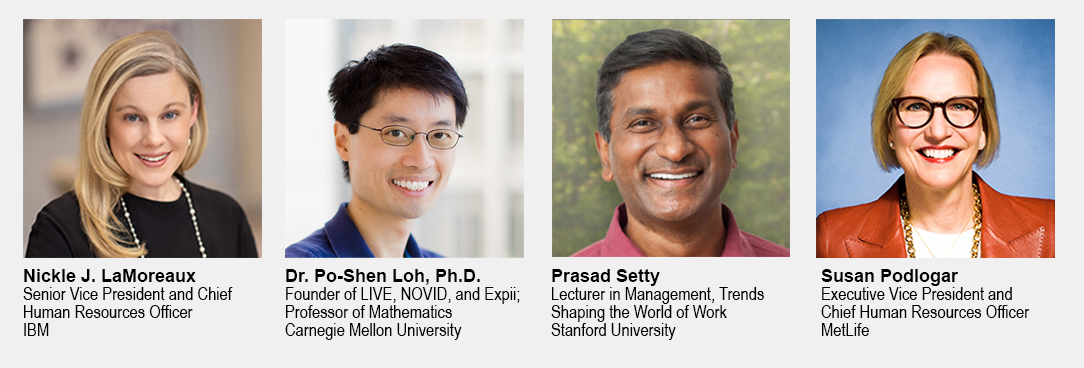
“The defining technology of this century.” Panelists discussed the enormous promise presented by AI for the workplace and workforce, and how the technology is here to stay, whether companies are ready for it or not. “The question isn’t what can I do now that I wasn’t able to do in the past – the better question is what will AI replace?” said Prasad Setty. Nickle LaMoreaux of IBM added that companies should think of AI not as a technology but as a platform that is changing the way work gets done. “Workforce planning will never be the same,” said Ms. LaMoreaux.
“Curiosity is King,” suggested Dr. Po-Shen Loh. In linking future workforce success to flexible and agile employees who can solve for new problems, Dr. Loh encouraged HR teams to scout for what’s next and hire for curiosity. If AI can handle the more mechanical tasks, for example video production, it frees up employees to think about what kind of video should be produced. This view was shared by Mr. Setty, who noted that AI can free employees from the amount of shallow work that consumes the day. “We do not have enough time to do deep work. We have so many emails to answer, we don’t get to the real stuff.” Ms. LaMoreaux emphasized this point in relation to workforce development, “AI will take away transactional work, so we need to skill people for higher value work.”
The panelists offered several key considerations for integration of AI into HR and the workplace, including:
- Ensuring that key decision-making still lies in human hands (“a human in the loop”), and that there are checks and balances in both directions between AI and humans.
- Companies are still defined by their people – AI is the platform, but companies should use the platform to augment their people, not replace them.
- Companies should consider how they can use AI to democratize access to skills, training, and benefits that were previously difficult to provide to the whole workforce (e.g., executive coaching through Gen AI).
- Understanding your business partner and legal team appetites for risk is essential.
“The biggest risk is inaction.” Each panelist emphasized the importance of acting now not only to integrate these new technologies, but to build out frameworks and guardrails to ensure their responsible and effective use. This responsibility largely lies with the CHRO, “The CHRO role is really the only one who can implement AI in your organizations in the way you need to,” noted Ms. LaMoreaux.
How Should AI Be Structured Within Companies for
Maximum Effect?
Ann Addison of Northrop Grumman led a discussion with Georgeann Couchara of Danaher on how companies are establishing their AI governance frameworks.
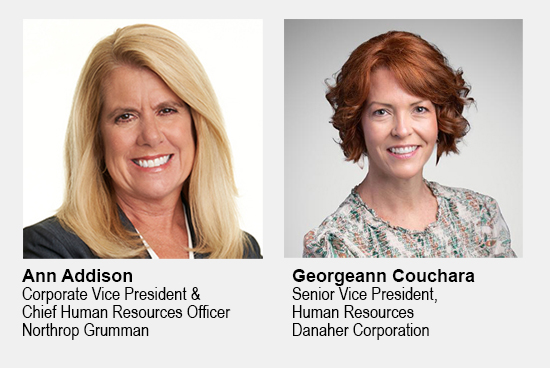
“HR has never been so exciting.” Ms. Addison opened the concurrent session reflecting on the potential for AI to improve productivity and innovation while helping to fill gaps caused by the shortage of skilled workers. She stressed the important role of CHROs in maintaining the human side of the technology, noting that companies should view AI as a tool to reach broader strategic goals rather than something to fear and suppress.
Restructuring HR to be compatible with AI. Ms. Couchara discussed how the current structure of their HR teams are not very compatible with AI. To fully integrate AI into the business, as well as within HR teams, Danaher continues to undergo restructuring so that AI can be used not only to improve productivity and efficiency for their customers but also for their internal teams.
Setting up governance structure. Both Ms. Addison and Ms. Couchara discussed how their companies are approaching setting up governance processes around AI. Frequent meetings with teams comprised of legal, IT, and HR allow leadership to gain a better understanding of the capabilities of AI and allow for regular feedback from team members regarding their experiences using the technology. Both companies utilize private, internal systems as they navigate the security of this technology and have created roles for someone to lead this integration whether through a Chief Scientific Officer or Chief Information Officer. Danaher is adding a new role, Chief AI Officer, that will initially report directly to the CEO.
Crucial that data teams understand HR. In order to use AI to its full potential in HR, it is important that technology or science teams work closely with HR so they understand what HR teams need. Many companies have an AI team within HR. This person often serves as a liaison to IT, but without some kind of integration, many AI programs will not be built in a way that is useful to the function.
Good AI Governance, Ethics, and Legal Compliance
Michael Fraccaro of Mastercard was joined by the Hon. Keith Sonderling, EEOC Commissioner and Oliver Patel of AstraZeneca for a discussion on the regulatory frameworks and legislation being developed in response to growing uses of artificial intelligence in the workplace.
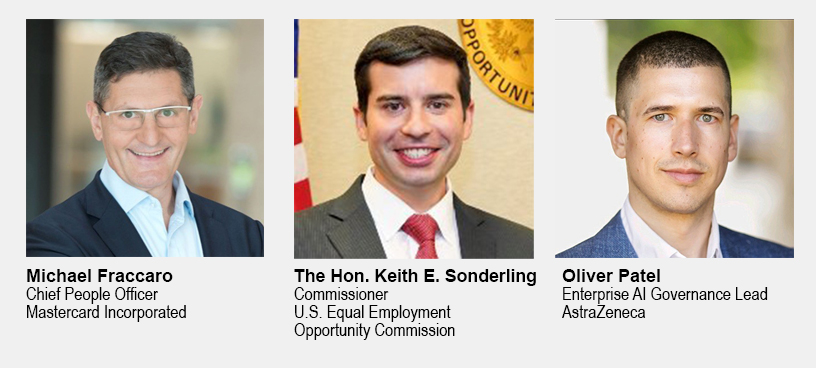
Europe takes the lead. Mr. Patel provided an overview of the recently passed EU AI Act, which is the world’s first comprehensive law regulating the use of AI. Mr. Patel emphasized that the law was horizontal, encompassing the full spectrum of AI use cases, in contrast to some recent U.S. laws which have been more vertically tied to specific use cases. While certain uses are prohibited, most are classified according to risk with different requirements for each.
“Absolute chaos.” Mr. Sonderling discussed the incoming onslaught of AI regulations and laws within the U.S. and across the world, with a variety of different regulators taking different approaches. Mr. Sonderling emphasized that despite the different use cases, at the end of the day, it is the employment decisions that will matter (at least under U.S. law) – and thus current employment and labor laws can and will still apply.
What happens when the dust settles? All the panelists stressed the uncertainty associated with overregulating AI when its uses are still in the process of being developed. “By regulating all of these use cases now, it is very difficult to know what the unintended consequences will be,” said Mr. Patel.
“You can’t prevent yourself from taking the plunge.” Mr. Fraccaro emphasized the importance of moving forward with AI adoption regardless of where the law is going. Mr. Fraccaro also discussed how organizations need to bring all teams together to make it work including HR, legal, and business partners.
How CHROs Can Reinvent Work and Unlock
Innovation with Gen AI
Ellyn Shook of Accenture and Alan May of Hewlett-Packard Enterprise discussed the framework CHROs should use in assessing AI and its adoption across the organization and showcased how a client used AI to improve the performance for their sales function.
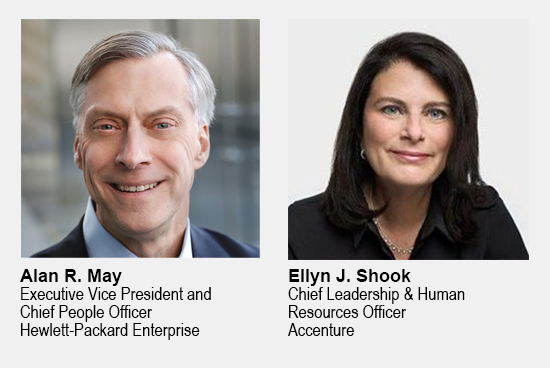
“If you use Gen AI to its fullest capability, you will reinvent your company,” Ms. Shook remarked as she described five C-suite imperatives:
- Lead with value;
- Understand and develop an AI enabled digital core;
- Reinvent talent and ways of working;
- Close the gap on responsible AI; and
- Drive continuous reinvention.
A pivotal moment. CHROs can reinvent work, reshape the workforce, and prepare workers for transformation by reflecting on AI first from an enterprise level, then from a workforce perspective and finally as an HR function.
Think broad and deep with enterprise-wide leadership. Think like a CEO. Establish and communicate ethical practices for AI. Mr. May suggested reviewing existing AI principles and customizing them to build an organization specific strategy.
Build AI literacy across the organization by digging deep to understand the data sources that will feed AI and identify the highest leverage use cases for the business. Mr. May reiterated the importance of this area stating, “What’s different about AI is that it is a living data set that will continue to be scraped and get smarter and smarter. It will learn more quickly than people can. You have to be custodians of your own data sets.”
Ms. Shook stated the importance of “involving people in the process early to build trust.” Fear often arises when current processes are not documented so involve employees in documenting the current process before rethinking processes with the application of Gen AI.
Find opportunities within the HR function. Focus on the ROI and what will enhance the HR experience. Use this as an opportunity to upskill the team, clean up data and challenge suppliers.
Use AI to assess future relevant skills. Mr. May encouraged everyone to focus on tasks and not jobs. He indicated, “It is table stakes now to understand the current skills of employees and reaggregate them.” This becomes the basis for upskilling and helps organizations re-architect roles and tasks.
How Do I Plan for the Future Impact on the Workforce?
HR Policy’s Chatrane Birbal led a discussion alongside Christopher J. Fernandez of Microsoft Corporation and Po-Shen Loh, Ph.D. of Carnegie Mellon University, on the rapidly changing workforce landscape created by AI and how companies can prepare to integrate the burgeoning applications of AI into the workplace.
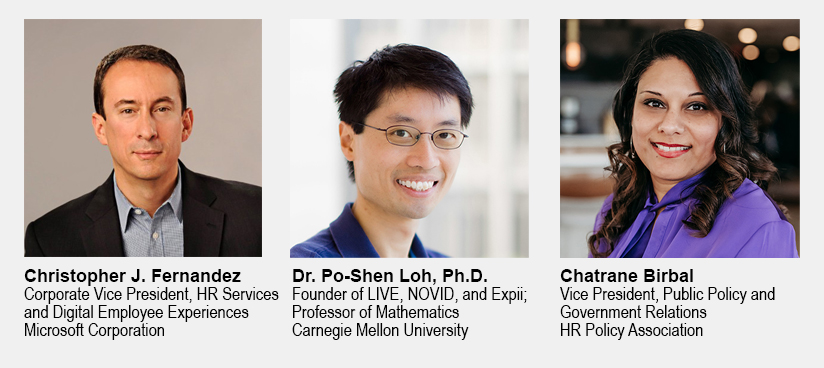
“CHROs play a critical role in evaluating the workforce impacts of AI usage and integration,” stated Mr. Fernandez while discussing job displacement and skill gaps. He discussed Microsoft's tech-labor partnership with the AFL-CIO which emphasizes transparency and collaboration in addressing the future of work, including sharing AI trends and incorporating worker perspectives. In addition, Microsoft’s collaborations with educational institutions aim to address skill requirements. The business community must continue to be proactive in addressing workforce concerns related to AI, utilizing metrics to measure the success of initiatives, and fostering a culture of continuous adaptation.
“Organizations must prioritize skills development and employee satisfaction” when navigating the changing landscape related to workforce dynamics in the age of AI, Mr. Fernandez counseled. This entails fostering a culture of learning, curiosity, and adaptability, while promoting responsible AI use through transparent decision-making processes.
For CHROs, “engaging employees who work with AI requires open communication, training programs, and opportunities for collaboration with your workforce” stated Po-Shen Loh. Drawing on his educational experience, he further stated that promoting continuous learning becomes crucial for organizations to remain competitive and relevant amidst rapid technological advancements. Looking ahead, CHROs should anticipate ongoing changes in workforce development, strategizing to stay ahead by embracing innovative training methods, fostering inclusivity, and aligning workforce strategies with emerging AI trends.
CHROs will continue to play a critical role in an organization’s integration with AI, by prioritizing skills development, and employee satisfaction, while also addressing the need for continuous training and learning opportunities.
CHRO Lessons From Recent Collective
Bargaining Agreements
Ernest Marshall moderated a discussion featuring Jennifer Berres and Thomas Beck of HCA Healthcare, and Darrell L. Ford and Lindsay Marshall of UPS on lessons learned from recent union organizing campaigns and collective bargaining negotiations.

“It felt like we were negotiating on behalf of the country.” Mr. Ford and Mr. Marshall shared their experiences in negotiating UPS’s latest collective bargaining agreement with its employees amongst the current, highly charged and highly politicized labor relations environment. Mr. Ford detailed UPS’s three-part strategy:
- Winning for their customers and providing business continuity;
- Winning for the union; and
- Winning for UPS.
Mr. Ford also noted the importance of properly communicating with the Board during such a high-profile negotiation, particularly given that the majority of the company’s Board had never been through a labor cycle.
Leverage vs. relationship bargaining. Lindsay Marshall emphasized the importance of UPS’s longstanding relationship with their union and its leader Sean O’Brien, which helped spark great behind the scenes communication. Even as the negotiations created significant media attention, UPS knew the relationship it had would drive a beneficial agreement for all parties.
Unions have upped the ante since the COVID-19 pandemic: Ms. Berres and Mr. Beck discussed the recent renewed aggressiveness of organized labor, with widespread organizing campaigns and unprecedented strike activity. This has put particular pressure on the healthcare industry, which is already facing significant staffing shortages. Mr. Beck noted that HCA now runs workshops for its executives and management on strike planning and labor relations in general. “We are taking the risk assessment to a much higher level,” said Mr. Beck.
Impact beyond unionized facilities. Ms. Berres emphasized that what HCA does at the bargaining table impacts their surrounding non-union facilities as well. Non-union employees will look at those results and decide whether they should be getting the same deal. “It’s important to weave your ‘great employer’ message throughout the organization,” said Ms. Berres. “The time is now to really double down on your employee relations and engagement strategy.”
Auto industry unionization spreads. Meanwhile, the United Auto Workers union looks to build off its recent successes at the Big Three Automakers. This week, the UAW filed a petition to represent workers at a Volkswagen plant in Tennessee, claiming it had support of more than 70% of the employees through signed authorization cards. A victory would mark the first time that employees of a foreign automaker unionized in the U.S.
CHRO Leadership & Resilience with Dr. Michael Gervais
In a session moderated by Duke Nelson of Microsoft, Dr. Michael Gervais joined Rhonda Morris of Chevron and Matthew Breitfelder of Apollo Global Management, for a candid discussion about who takes care of CHROs who are taking care of a stressed-out workforce and how “FOPO,” or fear of people’s opinions, serves as a major obstacle to human potential.
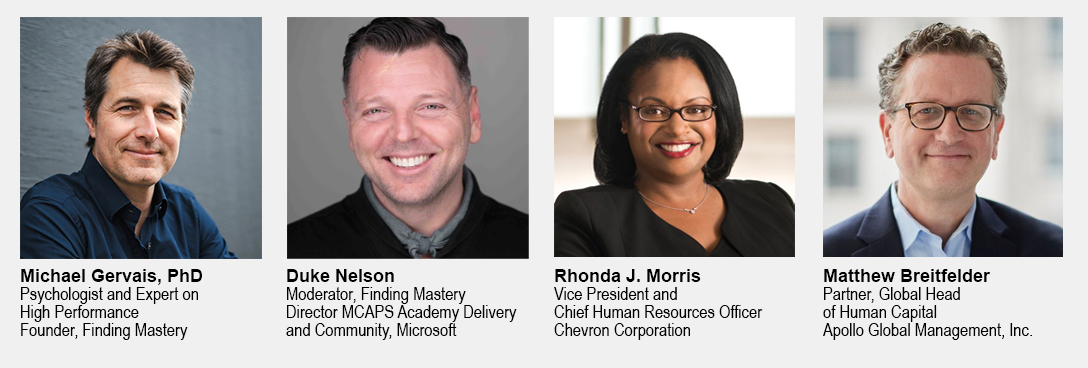
Seeing challenge as an opportunity is a mindset change that is available to everyone. Dr. Gervais, who has worked as a psychologist for high-performance athletes and businesses, discussed self-talk and how we can be our best, or our worst, coaches.
Gervais detailed the science of agility:
- Challenge – seeing challenge as opportunity and developing the mental strategies to handle being at the edge of our capacity.
- Control – controlling your recovery, your sleep, fuel, movement, and stress.
- Commit – committing to a purpose that is bigger than you and future focused.
Humanizing and modernizing companies is what enables sustainable success, commented Ms. Morris. The pandemic was recognized as a changing point, allowing us to humanize our workplaces and talk about wellbeing and mental health in ways that we have not done so before. She recognized Dr. Gervais as normalizing this focus through his work with athletes and companies.
“Cover” from leadership and support from colleagues can be a key to successfully introducing wellness practices at work, mentioned Mr. Breitfelder, who has worked with Dr. Gervais and introduced a group meditation for the senior leaders at Apollo.
The panel concluded by noting that as leaders become more comfortable talking about human needs in the workplace, this mindset permeates the entire organization resulting in a shared language and reinforcement.
The Global Socio-Political Environment with Dr. Timothy Naftali
Introduced by Monique Herena of American Express, Dr. Timothy Naftali, historian and adjunct professor at Columbia University, held a captivating talk on the current state of the world, plainly laying out the challenging landscape within which CHROs must operate. Employees, customers, and investors place higher expectations on companies, trusting them more than they do the government and media.

External geopolitical threats. Dr. Naftali covered the conflicts between Russia and the Ukraine, Israel and Hamas amid larger tensions in the Middle East, and China and Taiwan, helping to explain the history of the conflicts, historical patterns, and suggesting possible outcomes. On Russia/Ukraine, he noted that Putin is using Soviet-era strategies to take over Russian-speaking areas. On the Middle East, he raised how delicate the situation is, and the specter of Iran and potential of a larger war.
Internal challenges. Addressing the conflicts in the United States, Dr. Naftali drew attention to the bond that the common experience created for the generation of Americans that fought alongside each other in Europe and the Pacific, which led to their ability to work with others to get things done for the country upon return. He lamented that we are losing our shared experience of fighting a common enemy and, as a result, no longer fully share in a common “American Dream.”
Extolling the need to share historical facts, Dr. Naftali concluded with a plea for empathy and honesty in our dealings with one another.
The 2024 Election: Implications for Large Companies
Introduced by Sarah King of Darden Restaurants, The Honorable Val Demings urged attendees to reflect on the Preamble of the Constitution and remember that America’s founders built a nation that can rise above any challenge. Recognizing the fact that we are “living in tough times,” Rep. Demings highlighted the volatile political climate’s impact, making the CHRO job “much harder.”

Rep. Demings urged attendees to resist the politicization of workplace issues, like recruiting, commenting that “we are stronger, smarter, better, when your companies reflect the diversity of the nation we serve...we need your voices saying that diversity is our strength.” In the midst of the election cycle, Demings focused on the rule of law, urging “Your commitment to your employees should not change with presidents.”
Is There a Global Resurgence in Union Power and Influence?
Gregory Hoff and Wenchao Dong of HRPA were joined by Wilma Liebman, former Chair of the NLRB, Keith Sonderling, EEOC Commissioner, and Matt Walter of Medtronic, exploring trends in labor relations within the United States and globally, analyzing the recent resurgence in union activity and its impact on member companies and their strategies for managing labor relations on a global scale.

Discussing the trajectory of labor relations under a potential second term of the Biden administration, Ms. Liebman reflected on global labor dynamics influenced by international agreements and collaborations similar to the USMCA. She highlighted the need for potential adjustments in American labor law to better reflect current realities, drawing insights from successful global models.
Providing a global CHRO perspective, Mr. Walter emphasized how crucial having a broader, global perspective is for ensuring a consistent and positive employee experience. Walter further stressed the importance of “adapting strategies to address pressing issues such as DEI, AI, and ESG, while remaining informed of global regulatory shifts.”
“We are seeing an unprecedented level of coordination” stated Mr. Sonderling when discussing the “whole of government” approach to workplace regulation. Employers should expect ongoing attention from the Biden administration regarding labor policies and regulations. With the rise of artificial intelligence, employers need to consider its impact on employee and labor relations and continue to focus on leveraging these technologies ethically and effectively while anticipating regulatory responses.
The panel discussed how labor relations is facing diverse challenges and opportunities. Their discussions highlight the need for adaptive strategies in the face of evolving circumstances, emphasizing the importance of addressing global issues such as DEI, AI, and ESG.
Maximizing Employer Influence for Next-Level
Employee Benefits
In a concurrent session moderated by HR Policy’s Margaret Faso, panelists explored how CHROs are currently evaluating their health care programs and using data to implement changes that enable better access, affordability, and quality for their employees. The session featured Tom Plath of International Paper, Susan Kelliher of Chemours, and Garrett Hohimer of the Business Group on Health.
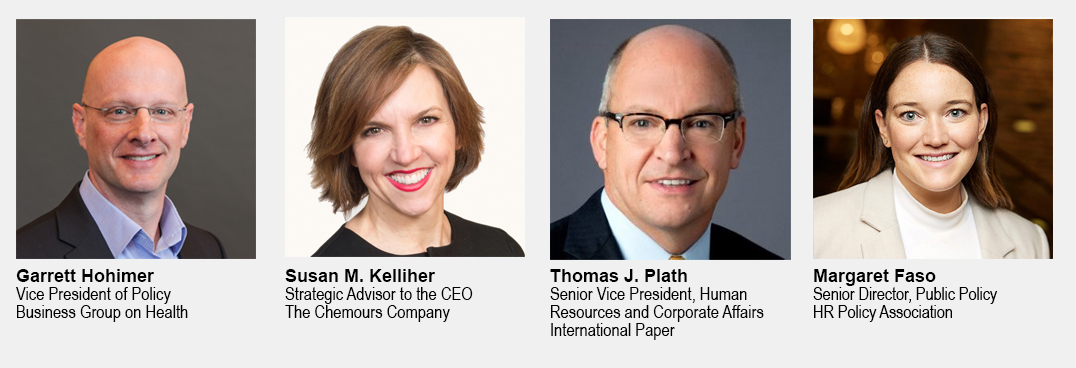
“No longer is health care a necessity that you manage passively. Now it is an opportunity to actively manage equitably,” Mr. Plath said in his opening remarks. He discussed the strategies used at International Paper that have resulted in decreased health care costs since 2019 and emphasized that employers need to “own their own data and leverage transparency to help reduce costs.” International Paper implemented concierge services to help reverse trends for those with underlying health issues and proactively asks for lower costs of highly utilized specialty drugs. He is also creating a fiduciary committee for oversight of the health programs, similar to the retirement program.
Ms. Kelliher said, “Our north star is to provide great care options at a great cost.” Chemours is focused on the things they can control within the complex health care system. The company starts with an open dialogue with employees where they provide consumer education and solicit feedback about what is working and not working with their plans to help inform future decisions.
Mr. Hohimer spoke of the policy issues at play surrounding the PBM Transparency bill – a broad bill where “implementation is everything,” citing a potential need to carve out small to mid-size employers due to HIPAA concerns. He also discussed the challenges employers will be faced with in compliance with the pending final Mental Health Parity rule as a result of lack of mental health care providers, the cash-only business model of current mental health providers, and the lack of integrated care networks that allow for primary care physicians to work together with psychologists and psychiatrists for comprehensive care. HRPA will put forth a CHRO Guide to help employers prepare for compliance when the bill is enacted.
Panelists also discussed the importance of ERISA preemption in companies’ ability to quickly adapt to employees needs and provide uniform benefits to employees across the U.S. HR Policy submitted comments to a House Education and Workforce RFI on ERISA, urging the Committee to “reject any attempts to weaken the federal restriction on state-by-state regulation of self-insured employers.”
ESG Pushback and the CHRO Role: A Business & Communications Imperative
Heidi Capozzi of McDonald’s, Mirian Graddick-Weir, Member of the Boards of Directors for Yum! Brands and Booking Holdings, and Tony Fratto of Goldman Sachs, spoke with HR Policy’s Ani Huang to discuss the precarious position that companies find themselves in during the ESG “tug of war.”
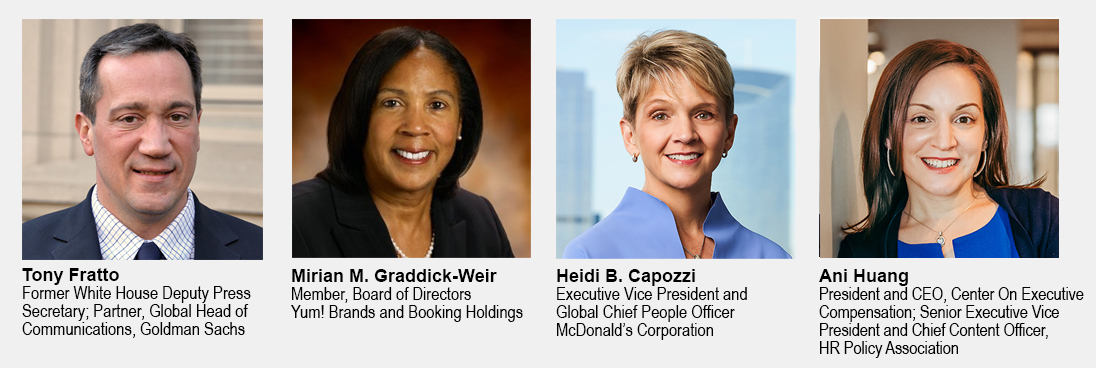
Engage the board on the communication framework. Ms. Graddick-Weir shared that her boards are “unwavering in their commitment for sustainability, climate and DEI,” but recognized that when companies “are threatened with legal action, you can’t ignore the vulnerabilities and risks.” She encouraged management teams to “engage the board on their playbook for making decisions” for when to communicate on ESG issues both internally and externally.
Determine the path forward. Ms. Capozzi discussed many of the public ESG commitments that McDonald’s has made and the strong progress achieved with initiatives aligned with their company values and brand. After experiencing backlash for not fully reaching an animal welfare goal and receiving opposing shareholder proposals on diversity initiatives, they “realized there were a lot of numbers put out over the years and we needed mechanisms for monitoring” them. The team created a strategic scorecard to measure their progress and gained valuable insights from auditing their commitments and measurements. “Rather than wait until you missed a goal, be proactive. We now think long and hard about what goals we put out there.”
Running into the fire. Mr. Fratto described his experience with crisis management citing “you run to the issues.” He emphasized that “If you don’t have the processes in place and trust with the right audiences in a regular and repeatable way, you will do it poorly.” Mr. Fratto suggested “early communication to employees on what you will not speak out on, things you will speak on and issues that you will take action through lobbying.”
